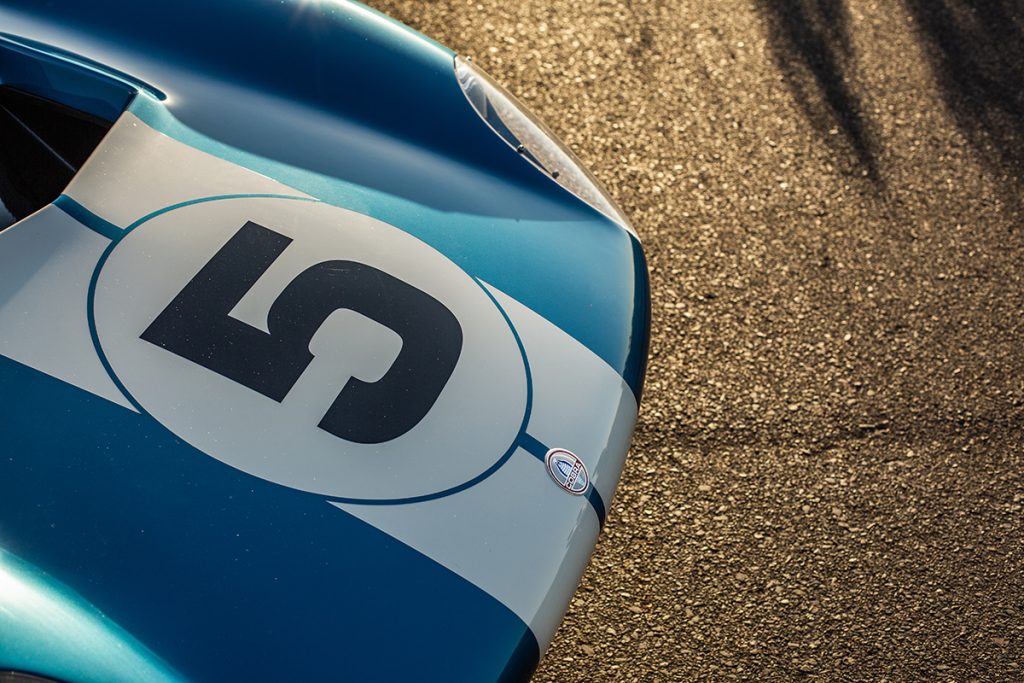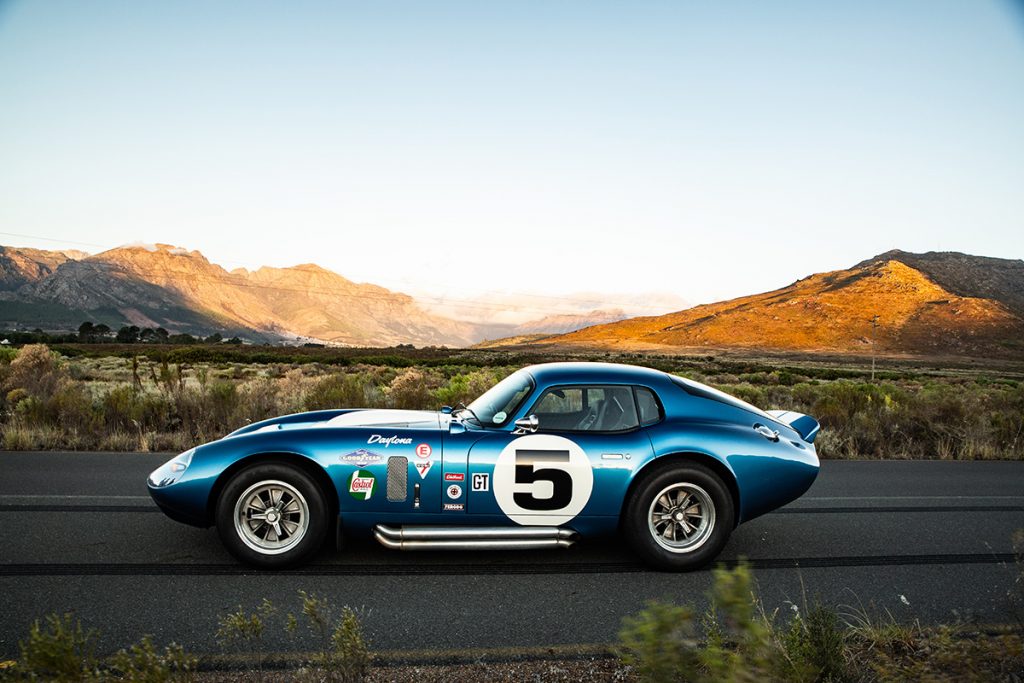THE COBRA’S SECOND STRIKE |
Mention Shelby, and one immediately thinks Cobra. However, to understand the significance of the purpose-built Pete Brock-designed “Daytona Car”, or the Shelby Daytona Coupé as it is generally referred to, one needs to investigate the 60-year history of the Cobra.
Why? Well, simply because the Daytona sports coupé owes its existence to the Cobra. It is related to the high-powered roadster and was essentially built as an advanced racetrack evolution of the iconic muscle car.
The well-chronicled history of the Cobra began six decades ago with the founding of Shelby American in Venice, California, by Carrol Shelby. Shelby’s earlier race experience ignited his interest in designing and building an all-purpose, all-American sports car – one that “you could drive to market and also race during the weekend”.
Shelby approached many European marques with his idea but was continually rebuffed until he contacted AC Cars. Without a suitable engine for the Ace, AC agreed to provide a chassis on credit if a suitable V8 engine could be sourced. After being turned down by Chevrolet, Shelby approached Ford, and wanting a car that could compete with the Corvette, the Blue Oval agreed to provide new Windsor 3.6-litre and 4.3-litre V8 engines with transmissions.
AC Cars modified the “AC Ace 3.6” prototype and freighted it to Los Angeles, where Shelby’s team paired the engine and transmission in less than eight hours. Production began in March 1962, and 75 Shelby AC Cobras with the 260-cubic-inch engine were sold by the end of that year.

Le Mans Challenger
Motivated by the success of the Cobra as a GT race car, Shelby started work on his ultimate dream; to beat Ferrari at Le Mans with a car of his own design. However, he soon realised that the weakness of an open-top sports car at Le Mans was its aerodynamic drag, which limited top speed.
Attaining only about 253 km/h on the 6 km long Mulsanne Straight – about 50 km/h less than a Ferrari 250 GTO – meant losing nearly 10 seconds per lap, negating any of the Cobra’s power advantage. So, he commissioned Pete Brock to design a new, aerodynamic body and Bob Negstad to design the suspension.
Brock sketched the proposed Daytona design on the floor of the Shelby America workshop. He first designed the windscreen, then interspaced wooden formers and used them as a guide to hand-form the bodywork for the chassis around them.
The short Kamm-tail was at odds with the assessment by Ben Howard, an aero consultant from Convair, but Brock stood by his design, and in testing, the car, also referred to as the “SPF Brock Coupé”, proved quick, clocking speeds of over 310 km/h. It was on pole for its debut race at the Daytona Speedway.
Only six Daytona Coupés were built; the first in California and the others at Carrozzeria Gransport in Italy. A seventh car, the “Type 65” Super Coupé prototype with a 7-litre V8 engine, was developed but never officially completed by Shelby (it was finished later on and still exists today but isn’t recognised as a true Daytona).

Racing Pedigree
During 1964 and 1965, the Shelby Daytona Coupés were entered at numerous long-distance races in the GT Division III of the International Championship for GT Manufacturers, for cars with engine displacements over 2,000 cc.
Shelby realised his initial goal when a Daytona, driven by Dan Gurney and Bob Bondurant, finished fourth overall in the 1964 Le Mans 24-hour race, winning in its class ahead of two Ferrari 250 GTOs. The cars also competed at Sebring, Imola, Reims, Spa, Goodwood, Oulton Park, Enna, Rouen, Monza, and Nürburgring.
The following year, a Daytona driven by Jack Sears and Dick Thompson again won its class at Le Mans, helping Shelby become the first American constructor to win a title in the FIA International Championship for GT Manufacturers (by 19 points).
The Daytona Coupé remains the first and only American-made car to win the FIA World Manufacturers Championship for GT cars – while transforming the American road racing scene. It is revered to this day, and worldwide demand saw a continuation series of the type, licensed by Carroll Shelby.

Continuation Series
So, what better way to celebrate 60 years of the Shelby Cobra than by getting acquainted with a continuation series replica of the meanest, loudest, brashest and most exclusive derivative of ’em all?
Some time ago, Dawie Theron, an avid collector of sports and classic cars, some of which he keeps in Franschhoek, acquired a Superformance CSX9000 Series “SPF Brock Coupé”, a continuation of the Shelby Cobra Daytona Coupé built by Jimmy Price’s Hi-Tech Automotive company in South Africa and distributed globally through Superformance.
The Daytona continuation model has several modern modifications, including a refined double-wishbone suspension with coil-over shocks, vacuum-boosted dual-piston Shelby brakes and power-assisted rack-and-pinion steering. Boasting original Halibrand-style wheels and side-exit exhausts, it really looks the part.
Tipping his hat to the Daytona’s proud history, Dawie chose to have his Daytona painted in classic Guardsman Blue with Wimbledon White Le Mans stripes. Complemented by Carroll Shelby inscriptions, including Shelby’s signature, the car proudly carries the number 5 – the racing number of the most successful of the six Cobra Daytonas (chassis CSX2299), including its first class win at Le Mans, in 1964.
While continuation series Cobra Daytonas usually come with small-block V8 engines, Dawie decided to equip his example with a big-block Shelby fettled aluminium Ford 427 FE Cobra V8 engine pushing close to 400 kW at 6,000 r/min and 650 Nm of torque at 3,700 rpm.

7-litre V8 power
The din of the 7-litre V8 firing up shattered any semblance of Franschhoek serenity, burbling raucously as we idled through the quaint town, the sound reverberating off the walls of the well-maintained buildings and inside the snug, two-seat cabin with its figure-hugging sports seats.
Facing me in the spartan interior was a cluster of Stewart Warner instruments, a double row of toggle switches and an old-school three-spoke steering wheel, with a sturdy gear lever for the Tremec manual gearbox and handbrake next to me on the centre console.
Even with power steering, I had to manhandle the beast at slow speed, and the clutch action was heavy, while the five-speed ’box necessitated measured gear changes – as expected from a ‘60s sports racer with a heavy lump of an engine up front, a limited-slip diff and outsize tyres (275/40s at the rear and 245/35s in front) on 18” rims.
However, the slightest prod of the loud pedal leaves you under no illusion of the latent potential under the Daytona’s hood, and weighing just over 1,300 kg, this can be transmuted into a bellowing, tyre-smoking run of 4.1 seconds from 0-100 km/h if the car is launched correctly.

Last Word
Accompanied by all the right mechanical noises (and a surprisingly agile turn-in capability), a quick blast up Franschhoek Pass endorsed its sporty credentials and again sanctioned the highly addictive nature of the experience – You just don’t want it to end!
And this (besides being a sound automotive investment) is precisely why real car enthusiasts still revere the iconic sight and sound of true-blue American muscle – 60 years after the first ground-shaking start-up of the first Shelby Cobra V8, pioneering the way to its illustrious coupé offshoot.
Report by Ferdi de Vos | Images © Ryan Abbott



